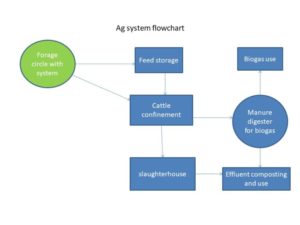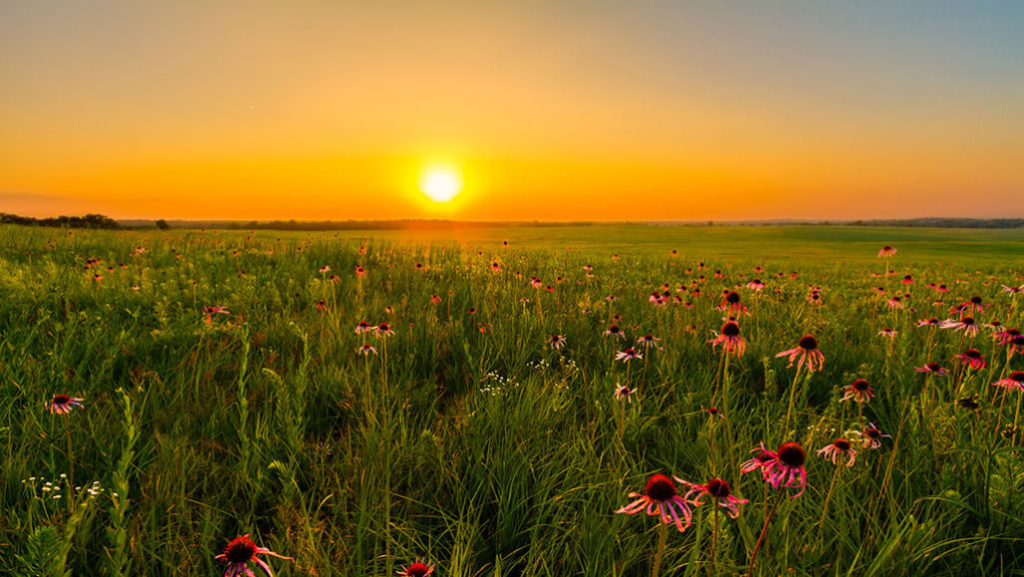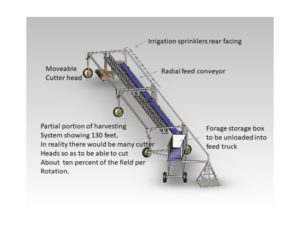Prairie Grass Systems: Texan’s Invention Remineralizes Soil While Replenishing Native Flora
Imagine an irrigation system that does not rely on clear water to run through its small tubing orifices, but rather can provide a nutritious ‘dirty’ water, filled with fine rock dust and other particulates that can optimally feed soil microbes. That will be just one of many benefits with David Munson’s Prairie Grass Systems.
“We take a water slurry mix and inject it under the plants to provide a little bit of water to the plants, but also food for the soil organisms to attack the rock dust and feed the plants,” he says about his patented invention that allows for maximum production of forage crops for cattle — native prairie grasses ideally — without cutting or grazing those plant species out of existence. “Prairie grass gets killed out by hard grazing.”
According to Munson, president of the Get Real Alliance, his invention includes overhead support frames to hold up cutter-heads to cut forage at any desired height for optimal growth and use. Cutting forage several feet high facilitates rapid regrowth and better-quality grasses, which ultimately eliminates reliance on crops such as corn for livestock feed — something that is better for the local ecosystem, as well as for the cattle.
“It solves all the problems we face of soil loss and nutrients depletion, and use of agricultural chemicals to try and grow crops not native to the region. Corn is not a crop that evolved in nature in the Midwest of the U.S. Native prairie grasses existed for thousands of years once soil reformed after the [Last Glacial Maximum]. The optimal crop to come in and feed millions of buffalo was native prairie grass. It’s super nutritious, but it can’t stand continuous grazing.”
He adds: “Cattle love it, because it’s the most nutritious grass, but they’ll literally eat it to the ground, which will deny [the grass] roots of energy and it just dies out.”
Break
‘Beefed up’ irrigator
Once built, each Prairie Grass Systems device would resemble a “beefed up” version of a conventional irrigation system, notes Munson. Each unit includes the addition of grass-cutters travelling in set arches, moving slightly into new arches after each revolution and repeatedly mowing the grass at set heights, with the clippings hauled off as cattle feed. “The grass has a chance to regrow, build roots and put carbon into the soil, and build up soil fertility.”
Since this system runs on set tracks, which are distantly spaced, most of the prairie grass is not compacted by either tires or bovine hooves across the fields, he says, meaning that soils become “airy and uncompacted” for optimal water and air penetration, which facilitates maximum vegetation growth.
“Because the native prairie was a polyculture of many plants, lagoons can be included to produce the needed fertilizer for the ground, and the needed nitrogen can be produced in lagoons in the mixture. And so, you have a situation where you can produce a tremendous amount of beef without fertilizer and without chemicals.”
He adds: “If you keep animals in confinement, then you can gather all the manure and bio-digest it for renewable natural gas to provide power. Effluent from the bio-digester is a rich fertilizer that my system can use and inject into fields, providing more fertility and a kind of nutrient cycle.”
Break
Texas pilot
 Ultimately, the Texas engineer and inventor envisions a higher-end, ethically-superior means of producing beef that, in part, incorporates the inclusion of natural grasses into the diet of cattle. Fortunately, once he secures funds to build a prototype, Munson has found a fellow Lone Star State rancher who is willing to pilot Prairie Grass Systems.
Ultimately, the Texas engineer and inventor envisions a higher-end, ethically-superior means of producing beef that, in part, incorporates the inclusion of natural grasses into the diet of cattle. Fortunately, once he secures funds to build a prototype, Munson has found a fellow Lone Star State rancher who is willing to pilot Prairie Grass Systems.
“He’s putting in a slaughterhouse for cattle on his property, and planning on raising and finishing grass-fed beef and letting them walk to the slaughterhouse for an optimal stress-free final day, where they won’t be herded into a big truck and subjected to all that stress,” he says, adding the rancher also has an abundance of freshwater on his property, which he intends to use for raising steelhead trout onsite in large concrete tanks.
“[The rancher] will take water from the fish tanks, which has fish waste in it, and irrigate his fields with it. It would be ideal for my system [to] constantly irrigate the prairie grass with nutrient-rich water.”
Break
Carter Haydu is a journalist and professional writer with more than 13 years of experience. Since 2012, he has written primarily on the Alberta energy sector for a Calgary-based trade publication. Much of his work has dealt with environmental issues facing the upstream oil and gas industry. In 2018, Carter attained a technical writing certificate from a reputable Canadian university. He hopes his skillset can support RTE’s sustainable initiatives.
Support us on Patreon
Thank you for joining us today! Please become a member of RTE and support us on Patreon. Unlike many larger organizations, we work with a team of determined and passionate volunteers to get our message out. We aim to continue to increase the awareness of remineralization to initiate projects across the globe that remineralize soils, grow nutrient dense food, regenerate our forests’ and stabilize the climate – with your help! If you can, please support us on a monthly basis from just $2, rest assured that you are making a big impact every single month in support of our mission. Thank you!










Nicole
September 22, 2021 (12:00 pm)
The story and the invention seem miss the point entirely. He advocates keeping cattle in confinement and raising trout in concrete tanks? And claims that this can be done without chemicals?
Just as buffalo did not need a patented invention to graze the praries into deep fertile soils and carbon stores, ranchers don’t need machines in order to graze cattle responsibly on nutritious native grasses and forbes.
Joanna Campe
September 24, 2021 (2:28 pm)
Comment from David Munson:
We live in a world with a shortage of food and my goal is to produce more top quality grass fed beef that is more palatable to consumers than much pasture raised beef which gets inadequate nutrition for top performance. Native tall grass prairie grass is very efficient at converting sunlight into top quality forage but is very difficult to graze where the grass remains tall and growing. My invention is intended for soil that gets muddy where there is large waste if cattle are placed in a field. The Buffalo trampled much of the forage as they moved across the land in a one time grazing operation as they kept moving to stay ahead of the predators (wolves). These packs of Buffalo would have left behind a wide swath of trampled vegetation that would recover after many months. WE must be more efficient than nature to feed a hungry world with shrinking land. The property that I talked about as an example has poorly drained soils that will be destroyed by intensive grazing but the land can be very productive growing native grass mixtures such as Gamma grass that likes wet conditions. Cattle prefer dry conditions where they can comfortably lay down. And shade or protection from weather. IF we are going to move away from corn fed cattle and return some of the farm land to native prairie grass we must be more productive than grazing cattle on the land which is in many cases not optimal to have intensive grazing on it. I have had a long career in agriculture culminating with a successful grass fed beef operation on highly productive land that was well drained but have seen fields destroyed by cattle grazing when muddy as many fields get. The ideal end of life experience for cattle is to walk to the slaughterhouse on their final day so as not to have any stress and to be with cattle they have been with. To do this you need concentrated cattle near a small slaughterhouse that is optimally designed to be as humane as possible for animals and workers. My prairie grass system with its higher productivity of the grasses should be able to feed 2 animals per acre per day. Or more as no one has ever managed prairie grass in an optimal way with no compaction and ideal harvesting height as well as subsurface irrigation with nutrients added. Having the animals in confinement makes it easy to gather the manure for biodigestion for energy and concentrating nutrients to add back to the land. I fully believe that prairie grass can be grown without chemicals and if fertilizer is used in much smaller quantities that doesn’t leach away as the soil will be porous and with the added organic matter very productive. Adding rock dust is why Remineralize the Earth was interested in my project as the idea of permanent native grass prairie again. There will be more detail on http://www.prairiegrasssystems.com over time as this is just a start and there is much development to be done.
Joanna Campe
September 24, 2021 (2:30 pm)
The mission of Remineralize the Earth is to facilitate a worldwide community of people who are interested in remineralization in its many forms and to report on those activities. RTE itself is an organization that is fully committed to partnering only on projects that clearly fit into an ethically sustainable and regenerative agriculture. Remineralization is a key strategy to transition industrial agriculture over to regenerative agriculture. This article really points out the complexity of achieving this goal and the ethics by which we arrive there. I welcome comments that address this very important issue.